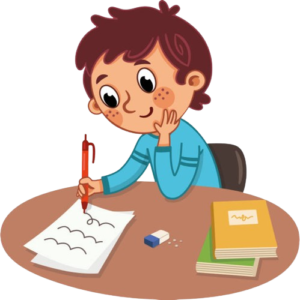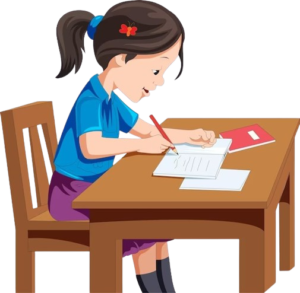How to handle Reluctant Writers
Handwriting text is frequently laborious and painful, resulting in everything from hand cramps to extreme sweating and high anxiety. Due to the incapacity to take notes, this can eventually result in subpar performance and falling behind in the curriculum. It might also cause people to avoid participating in writing-intensive extracurricular activities and schoolwork. Motivating children to write can be difficult, especially, for children who dislike handwriting assignments. Hence, it is critical to make handwriting exercises relevant and appealing for children in order to urge them to participate.

RESENTFUL WRITERS
Kids of all ages frequently express reluctance to write. Kids may simply dislike writing because of challenges like not understanding letter formation, dysgraphia, or issues with visual perceptual or visual motor skills that affect readability. They detest doing handwriting exercises.
When children are required to study subjects in which they have little interest, both school and home-schooling can be draining for them. And one of those is handwriting.
It might be difficult to get struggling writers to practise the fundamental skills that are holding them back. Meaningful and inspiring writing is essential for youngsters who HATE to write! These writing exercises for reluctant writers can make handwriting enjoyable so that kids can practise the necessary skills.
When a child is reluctant to start a writing work, a useful activity that is relevant and helpful can encourage them to want to pick up a pencil. Try out some of these useful handwriting exercises:
- Write out the family grocery list.
- Write out the phone messages from an answering machine.
- Write out the day’s schedule on a weekend day.
- Write out favourite television shows. Add the day, and time of each show.
- Write out a holiday or birthday gift wish list.
- Write out a list of items to pack for vacation.
- Encourage handwriting that doesn’t look like schoolwork or homework.
- Write cards or postcards.
- Use copy work. (write out a single word)

How does the handwriting of an individual reflect on their personality?
Above 80% of the world’s population is literate in any one language and can read and write that particular language. Four-fifth of the people in the world can write and every person possesses a different writing style. Handwriting styles generally fall into three broad types such as print, pre-cursive and cursive. However, all of us have a handwriting which is unique to us. Handwriting styles may be few in number but there are many writing styles within these handwriting types that are adapted by different individuals. The handwriting of a person can help identify over 5000 of their personal characteristics. As shocking as it may sound, there exists a direct link between the handwriting and the likes and preferences including the personality traits of the individual. The study of graphology extends in the expertise of denoting one’s individual characteristics by studying their handwriting. This study can be used for various purposes such as profile studies, criminal records or even medical diagnosis.
Firstly, writing in small letters means that the person is introverted, concentrated and attentive whereas big letters point towards the person’s capability of being adaptable and people oriented. Then, maintaining wide spacing between letters shows that the person enjoys their personal space and freedom and narrow spacing on the other hand shows that the person likes being with people at all times which might even lead them to intrude others’ personal space at times. The slant of the handwriting also plays a major role in identifying the personality of the individual. No slant suggests that the person is not emotion-driven and follows a logical and practical thought process. Right-sided slant is the trait of a friendly and sentimental person who highly values friendships and relationships and left-sided slant is the trait of a self-oriented, reserved and introverted person. Rounded letters are a sign of creativity, pointed letters of intelligence and intensity and connected letters of decision-making and logical characteristics.
The way specific alphabets are written can also tell us about a person. Narrow loops while writing the alphabet ‘l’ denote the person is of restrictive and stressful nature and on the other hand wider loops denote the person’s calm and naturally expressive nature. How high a person places their stroke on ‘t’ depicts how high their self esteem is. Placing the tittle dot on ‘i’ high is a sign of a high imagination and writing ‘i’ with aloopeddot hints towards a childlike nature whereas a regular dot means that the person is observant of small details. Even the pressure applied while writing, the spaces left for margin, the speed while writing or the signature of the person can be taken into account while studying their handwriting.
What is 'Calligraphy'? What are its practical uses?

Calligraphy is usually associated with writing in beautiful fonts or artistic styles. Calligraphy is much more than a beautiful and stylish form of writing. It is a manual skill and a form of art which requires the calligrapher to handwrite the letters or symbols in an elegant and pleasant manner while maintaining the proportionality of each and every symbol. This form of writing aims to present the writing designs which portray the historical heritage of handwriting techniques and patterns. Calligraphy not only promotes linguistic skills but also creative skills and enhances the viewer to read the same picture from a new perception. Calligraphy can also help learn the history or origin of a writing form.
Calligraphy has been evolved and adapted by different regions of the world and can be classified on the basis of its regional origin such as Western Calligraphy, East-Asian Calligraphy, Indian Calligraphy and Arabic Calligraphy. This art form had declined with the flourishment of the printing press era but did not lose its essence and was revived after centuries during the Arts and Crafts movement in the nineteenth century. Modern calligraphy has gained importance as a form of art in the digital era as well and has also been evolved in a digital form. In the present day it is widely used for adding an element of grace and grandiose to any important document such as book covers, certificates or records, special invitations and is also incorporated into various font styles and digital forms of art and media.
Calligraphy can also be used to create an impression or grab the attention of people because beautiful writings and designs can never go unnoticed. Customizing various documents, letters or envelopes with calligraphy is costly and learning calligraphy can help in earning money by providing personalized services. Apart from this, it can be used on websites or pamphlets to make the content more attractive. This requires providing digital calligraphy services and developing designs which are also a great source of income. Calligraphy is not just a form of design which can be incorporated into various important documents, web pages, books, movies or official letters to produce content that stands out and catches the eye of the viewer, but can also be learnt as a skill which creates multiple opportunities to work in the field of art and design.
